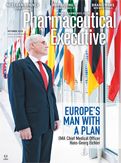Tablet Innovation: Sizing up the Value
Pharmaceutical Executive
The rising focus on difficulties in swallowing tablets spells a big opportunity for pharma.
Pharmaceutical companies have had a number of obstacles thrown their way in the past few years: the patent cliff continues to claim millions in revenue, R&D costs increase, and the number of approved medicines fall. On top of that, are the mounting regulatory requirements for approving both new and existing active pharmaceutical ingredients (APIs) and the vast initial capital required to bring a product to market. In an attempt to find solutions, drugmakers are looking to tackle these problems from new angles. A reliance on third-party companies is one path, allowing pharma to tap into external sources of innovation, deftly avoiding the risks of developing new active compounds from scratch. Others are moving away from hunting down novel APIs, instead reformulating existing medicines to make them more difficult to copy, while revitalizing ageing brands. Another, more complete strategy involves paying closer attention to how consumers and patients view and interact with existing products. This particular approach has brought some surprising perspectives to the forefront of medicine development.
A representative survey of Germans and Americans has revealed that solid oral dosage forms like tablets and capsules-the world’s "go-to" mode of medication-are far from optimal in many cases. In fact, 50% of people have problems swallowing medication in this form, resulting in many failing to adhere to their dosing regimen. These issues have a negative effect on compliance: 8% of the people surveyed reported abstaining from taking their medication altogether, rather than facing the difficulties associated with swallowing it. Of those that continued to take their medication, a portion had taken actions that potentially compromise the effectiveness of the drug, such a breaking up (32%) or crushing and dissolving (17%) the tablets or capsules before swallowing them.
This issue has recently also been recognized by the FDA, who has just issued industry guidance on the size and shape of tablets and capsules. This is a powerful acknowledgement of a widespread yet relatively unrecognized problem. The FDA report noted, “…difficulty swallowing tablets and capsules can be a problem for many individuals and lead to a variety of adverse events and patient noncompliance with treatment regimens.”
The FDA suggests that difficulty swallowing tablets and capsules can be addressed by controlling various physical attributes of the tablet or capsule. However, these recommendations fail to tackle the problem directly as patients still have to deal with dosage forms that are negatively impacting compliance and their health.
With such a wealth of convincing data, the widespread nature of this problem is undeniable. This situation needs addressing, and by doing so presents a rare opportunity for innovative companies to alleviate patient problems while generating new streams of revenue.
People demand more from their medicine
The survey from Hermes Pharma and the Spiegel Institut Mannheim explored the acceptance of conventional dosage forms compared with more user-friendly forms in 1,000 Americans. Difficulty swallowing tablets and capsules was reported across all age groups and genders. Interestingly, an even greater number of younger people (66% of 16–24 year-olds versus 40% of the 65 years-and-older group) reported this issue, although for different reasons. The size of a tablet or capsules was an issue for all, yet younger people also reported disliking the taste or odor of tablets/capsules. This is not entirely unexpected, since those in the younger age group have grown up in the "era of choice," where displeasing experiences are frequently challenged and expectations around choice and ease-of-use tend to be set a little higher.
In addition to being easier to swallow, it became clear that parameters such as taste and convenience are high on people’s list. Sixty-six percent of Americans reported that products should be easy and comfortable to swallow, 38% said that a pleasant taste or odor was important, and 34% suggested that a product should be easy to integrate into their daily routines. Over a third of the participants said that they wanted packaging that was easy to open. People have now come to expect more from their medication than just the intended medicinal effects; they also want it to be a positive experience.
Empower your customers with real alternatives
Today, people are better informed than ever before about their healthcare options thanks to the Internet and rise of social media. With a wealth of information available, patients are no longer willing to simply accept a product or medicine they’re not happy with.
This means that patients are starting to request specific products or brands from their doctor or pharmacist, making them a new determinant in the buying process. Medication selection has previously been under the explicit direction of the healthcare professional, but this balance has shifted. This can have consequences for the reimbursement models of healthcare systems, and balancing patient preferences with spending restrictions can be challenging in some cases. However, it remains undeniable that patients are now driving which medicines or supplements are dispensed, and they are making their preferences heard.
Alternative dosage forms like effervescent and chewable tablets, lozenges, orally disintegrating granules (ODGs), and instant drinks deviate from the standard tablets and capsules model, and fulfill the diverse needs of today’s patients. They can be developed in a range of flavors, are easy to swallow, and even integrate smoothly into people’s lives. These features meet many of the needs cited in the study. The most obvious benefit of these dosage forms is that, unlike tablets or capsules, they are easy to swallow and convenient to take, immediately alleviating the problem of swallowing experienced by so many people.
From a formulation standpoint, user-friendly dosage forms are less constrained by size than conventional dosage forms. This means that larger doses or even combinations of APIs can be accommodated in one dose, simplifying potentially complex dosing regimens making medicines easier to take and to integrate into daily routines. Dosage forms like effervescents for example, offer enhanced bioavailability due to the release of carbon dioxide as they dissolve, which improves permeability in the gastrointestinal tract and enhances API transport into cells. ODGs can be manufactured with extended and/or immediate release profiles, which is also an option for a selected group of sophisticated tablets and capsules. The difference is that ODGs do not require water for their intake, making them considerably easier and more convenient to take.
Addressing consumer preferences and meeting expectations is especially important in the wake of a rapidly growing over-the-counter (OTC) medicine market-expected to top $100 billion in the next few years. OTCs provide consumers the freedom to select their preferred medication and dosage form while giving them access to the treatment around the clock. People now frequently turn to these readily available medicines at the first sign of disease symptoms, instead of seeing a doctor. On average, US consumers make 26 trips a year to purchase OTC products, yet only visit doctors three times a year. This results in the average US household spending about $340 per year on OTC products. From pharma’s perspective, a greater focus on the OTC market provides more freedom and flexibility to determine sales prices (independent of the pricing policies of reimbursers) and the possibility of growing revenues and moving into new, less competitive market segments.
A user-centric approach benefits all
A move away from conventional tablets and capsules that cause problems for so many people is the logical conclusion of the results of the survey. Developing medicines that provide patients with a better experience and increase compliance should be at the heart of every new product development strategy. This allows pharma to differentiate products from the competition and to generate revenue by addressing the unmet needs of a broad range of individuals-around 50% of people are affected by difficulty swallowing tablets, yet the industry has been slow to address the issue. This extends to the creation of new medicines as well as the reformulation of existing products.
Such a strategy could also serve to boost patient health and reduce the burden of healthcare costs from problems such as non-compliance (in the US alone, this is thought to cost the healthcare system as much as $289 billion a year. Companies now have the chance to shift strategic gears and tackle these problems. A move towards making dosage forms more user-friendly seems to be a very effective and profitable opportunity. Those with the foresight to do so are turning to the consumers for inspiration, placing their preferences and requirements at the center of future developments.

Dr. Thomas Hein is Senior Vice President, Commercial and Regulatory Affairs, at Hermes Pharma, the third-party business division of Hermes Arzneimittel, a German OTC pharmaceutical company. He can be reached at info@hermes-pharma.com.

Is Artificial Intelligence a ‘Product’? Products Liability Implications for AI-Based Products
April 10th 2025As the physical products we use evolve to become increasingly complex, traditional products liability frameworks may not always fit to provide remedies for harm that can result from using novel product types.